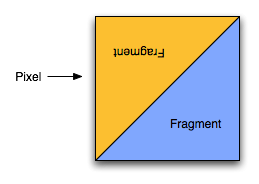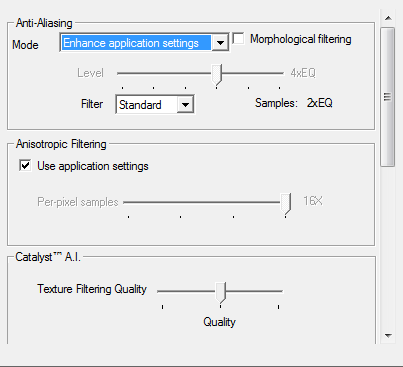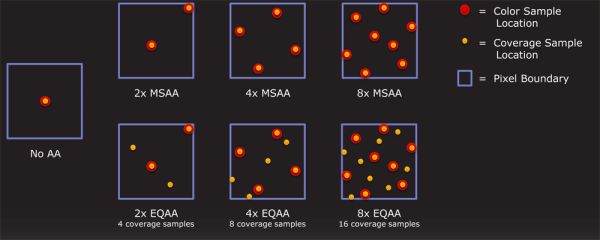AMD's Radeon HD 6970 & Radeon HD 6950: Paving The Future For AMD
by Ryan Smith on December 15, 2010 12:01 AM ESTAnother New Anti-Aliasing Mode: Enhanced Quality AA
With the 6800 series AMD introduced Morphological Anti-Aliasing (MLAA), a low-complexity post-processing anti-aliasing filter. As a post-processing filter it worked with a wide variety of games and APIs, and in most cases the performance overhead was not very severe. However it’s not the only new anti-aliasing mode that AMD has been working on.
New with the 6900 series is a mode AMD is calling Enhanced Quality Anti-Aliasing. If you recall NVIDIA’s Coverage Sample Anti-Aliasing (CSAA) introduced with the GeForce 8800GTX, then all of this should sound quite familiar – in fact it’s basically the same thing.
Under traditional MSAA, for a pixel covered by 2 or more triangles/fragments, 2, 4, or 8 subpixel samples are taken to determine what the final pixel should be. In the process the color of the triangle and the Z/depth of the triangle are both sampled and stored, and at the end of the process the results are blended together to determine the final pixel value. This process works well for resolving aliasing along polygon edges at a fraction of the cost of true super sampling, but it’s still expensive. Collecting and storing the Z and color values requires extra memory to store the values and extra memory bandwidth to work with the values. Ultimately while we need enough samples to determine colors of the involved triangles, we do not always need a great deal of them. With a few color/Z samples we have all of the color data we need in most cases, however the “hard” part of anti-aliasing becomes what the proper blending of color values should be.

1 Pixel Covred by 2 Triangles/Fragments
Thus we have EQAA, a compromise on the idea. Color/Z samples are expensive, but just checking if a triangle covers part of a subpixel is very cheap. If we have enough color/Z samples to get the necessary color information, then just doing additional simple subpixel coverage checks would allow us better determine what percentage of a pixel is covered by a given polygon, which we can then use to blend colors in a more accurate fashion. For example with 4x MSAA we can only determine if a pixel is 0/25/50/75/100 percent covered by a triangle, but with 4x EQAA where we take 4 color samples and then 4 additional coverage-only samples, we can determine blending values down to 0/12/25/37/50/62/75/87/100 percent coverage, the same amount of accuracy as using 8x MSAA. Thus in the right situation we can have quality similar to 8x MSAA for only a little over 4x MSAA’s cost.
In reality of course this doesn’t always work out as well. The best case scenario is that the additional coverage samples are almost as good as having additional color/Z samples, while the worst case scenario is that additional coverage samples are practically worthless. This depends on a game-by-game, if not pixel-by-pixel basis. In practice additional coverage samples are a way to slightly improve MSAA quality for a very, very low cost.
While NVIDIA has had the ability to take separate coverage samples since G80, AMD has not had this ability until now. With the 6900 hardware their ROPs finally gain this ability.
Beyond that, AMD and NVIDIA’s implementations are nearly identical except for the naming convention. Both can take a number of coverage samples independent of the color/Z samples based on the setting used; the only notable difference we’re aware of is that like AMD’s other AA modes, their EQAA mode can be programmed to use a custom sample pattern.
As is the case with NVIDIA’s CSAA, AMD’s EQAA mode is available to DirectX applications or can be forced through the drivers. DirectX applications can set it through the Multisample Quality attribute, which is usually abstracted to list the vendor’s name for the mode in a game’s UI. Otherwise it can be forced via the Catalyst Control Center, either by forcing an AA mode, or as is the case with NVIDIA, enhancing the AA mode by letting the game set the AA mode while the driver overrides the game and specifies different Multisample Quality attribute. Thus the “enhance application settings” AA mode is new to AMD with the 6900 series.

To be honest we’re a bit ruffled by the naming choice. True, NVIDIA did go and have to pick daft names for their CSAA modes (when is 8x not 8 sample MSAA?), but ultimately CSAA and EQAA are virtually identical. NVIDIA has a 4 year lead on AMD here, and we’d just as well use NVIDIA’s naming conventions for consistency. Instead we have the following.
| Coverage Sampling Modes: CSAA vs EQAA | ||||
| NVIDIA |
Mode (Color + Coverage) |
AMD | ||
| 2x | 2+0 | 2x | ||
| N/A | 2+2 | 2xEQ | ||
| 4x | 4+0 | 4x | ||
| 8x | 4+4 | 4xEQ | ||
| 16x | 4+12 | N/A | ||
| 8xQ | 8+0 | 8x | ||
| 16xQ | 8+8 | 8xEQ | ||
| 32x | 8+24 | N/A | ||
AMD ends up having 1 mode NVIDIA doesn’t, 2xEQ, which is 2x MSAA + 2x cover samples; meanwhile NVIDIA has 16x (4x MSAA + 12 cover samples) and 32x (8x MSAA + 24 cover samples). Finally, as we’ll see, just as is the case for NVIDIA additional coverage samples are equally cheap for AMD.











168 Comments
View All Comments
Remon - Wednesday, December 15, 2010 - link
Seriously, are you using 10.10? It's not like the 10.11 have been out for a while. Oh, wait...They've been out for almost a month now. I'm not expecting you to use the 10.12, as these were released just 2 days ago, but you can't have an excuse about not using a month old drivers. Testing overclocked Nvidia cards against newly released cards, and now using older drivers. This site get's more biased with each release.
cyrusfox - Wednesday, December 15, 2010 - link
I could be wrong, but 10.11 didn't work with the 6800 series, so I would imagine 10.11 wasn't meant for the 6900 either. If that is the case, it makes total sense why they used 10.10(cause it was the most updated driver available when they reviewed.)I am still using 10.10e, thinking about updating to 10.12, but why bother, things are working great at the moment. I'll probably wait for 11. or 11.2.
Remon - Wednesday, December 15, 2010 - link
Nevermind, that's what you get when you read reviews early in the morning. The 10.10e was for the older AMD cards. Still, I can't understand the difference between this review and HardOCP's.flyck - Wednesday, December 15, 2010 - link
it doesn't. Anand has the same result for 25.. resolutions with max details AA and FSAA.Presentation on anand however is more focussed on 16x..10.. resolutions. (last graph) if you look in the first graph you'll notice the 6970/6950 performs like HardOcp. e.g. the higher the quality the smaller the gap becomes between 6950 and 570 and 6970 and 580. the lower the more 580 is running away and 6970/6950 are trailing the 570.
Gonemad - Wednesday, December 15, 2010 - link
Oookay, new card from the red competitor. Welcome aboard.But, all of this time, I had to ask: why is Crysis is so punitive on the graphics cards? I mean, it was released eons ago, and still can't be run with everything cranked up in a single card, if you want 60fps...
Is it sloppy coding? Does the game *really* looks better with all the eye candy? Or they built a "FPS bug" on purpose, some method of coding that was sure to torture any hardware that would be built in the next 18 months after release?
I will get slammed for this, but for instance, the water effects on Half Life 2 look great even on lower spec cards, once you turn all the eye-candy on, and the FPS doesn't drop that much. The same for some subtle HDR effects.
I guess I should see this game by myself and shut up about things I don't know. Yes, I enjoy some smooth gaming, but I wouldn't like to wait 2 years after release to run a game smoothly with everything cranked up.
Another one is Dirt 2, I played it with all the eye candy to the top, my 5870 dropped to 50-ish FPS (as per benchmarks),it could be noticed eventually. I turned one or two things off, checked if they were not missing after another run, and the in game FPS meter jumped to 70. Yay.
BrightCandle - Wednesday, December 15, 2010 - link
Crysis really does have some fabulous graphics. The amount of foliage in the forests is very high. Crysis kills cards because it really does push current hardware.I've got Dirt 2 and its not close in the level of detail. Its a decent looking game at times but its not a scratch on Crysis for the amount of stuff on screen. Half life 2 is also not bad looking but it still doesn't have the same amount of detail. The water might look good but its not as good as a PC game can look.
You should buy Crysis, its £9.99 on steam. Its not a good game IMO but it sure is pretty.
fausto412 - Wednesday, December 15, 2010 - link
yes...it's not much of a fun game but damn it is prettyAnnihilatorX - Wednesday, December 15, 2010 - link
Well original Crysis did push things too far and optimization could be used. Crysis Warhead is much better optimized while giving pretty identical visuals.fausto412 - Wednesday, December 15, 2010 - link
"I guess I should see this game by myself and shut up about things I don't know. Yes, I enjoy some smooth gaming, but I wouldn't like to wait 2 years after release to run a game smoothly with everything cranked up."that's probably a good idea. Crysis was made with future hardware in mind. It's like a freaking tech demo. Ahead of it's time and beaaaaaautiful. check it out on max settings,...then come back tell us what you think.
TimoKyyro - Wednesday, December 15, 2010 - link
Thank you for the SmallLuxGPU test. That really made me decide to get this card. I make 3D animations with Blender in Ubuntu so the only thing holding me back is the driver support. Do these cards work in Ubuntu? Is it possible for you to test if the Linux drivers work at the time?